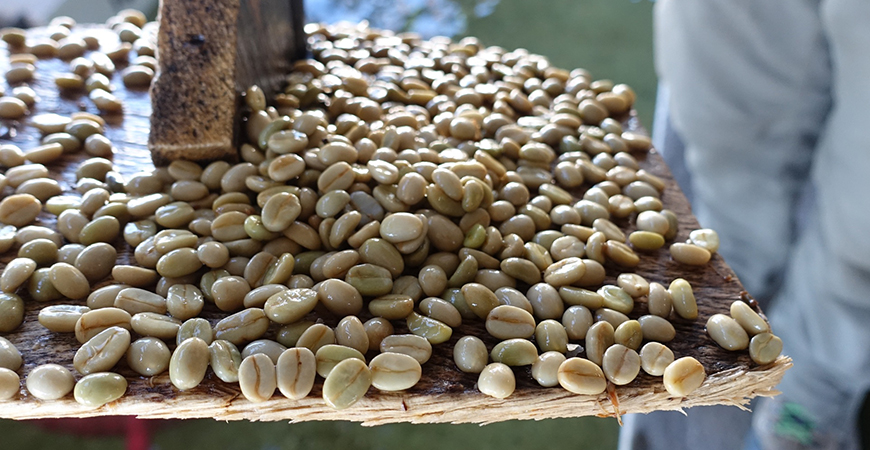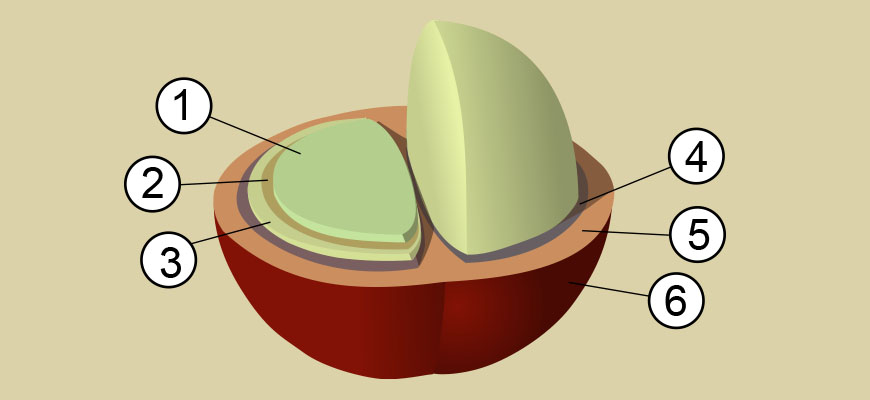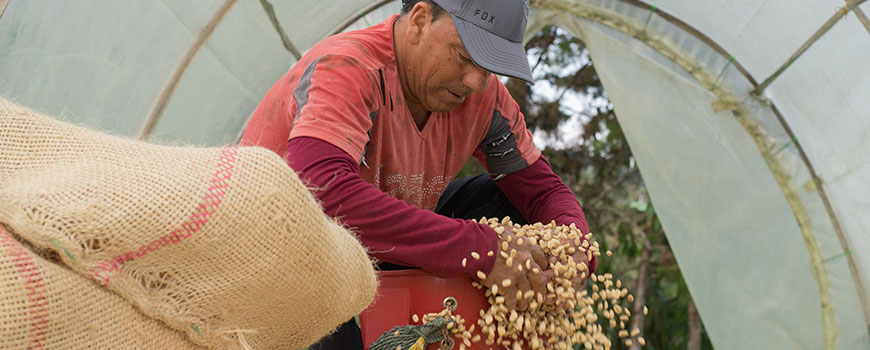- Free shipping in NL from €45
- Order before 12 PM, shipped same business day
- International shipping

Coffee processing methods

Processing methods of our coffees
We have been purchasing different types and sizes of coffee beans since 1973. These coffee beans are grown in different tropical countries. The country, climate, altitude and how you roast a coffee greatly affects the flavors you taste in your cup. What also plays a big role is the processing method you apply to the coffee bean after picking it. A coffee bean or actually coffee berry is always processed before it makes the crossing to our country.
You've probably heard of washed (washed) coffee and unwashed (natural) coffee. But what does this mean? And what does a processing method do to the taste of the coffee?

Unwashed coffee (natural coffee)
Every year we have unwashed coffees in our range: the Brazil Santos Espresso and our limited the Panama Hartmann Natural - Lot 34. Simply put, you can divide the processing methods into unwashed, washed and semi-washed. All methods aim to decompose the coffee berry, removing the pulp so that only the coffee bean remains. The way to get there is only different for each processing method.
Unwashed coffee is the oldest processing method in existence. It is sometimes said to be the easiest method, but there is a lot of precision involved in this process. The picked coffee berries are dried in the sun. The coffee berry dries out making it easy to remove the bean with a huller. This is a machine that crunches the coffee cherries and pushes out the coffee beans. The drying process takes between 8 and 12 days. This depends on the weather. It is important to remove the coffee berry in time, otherwise there is a risk of over-fermentation. Drying in this way is done on patios or on raised drying beds. We prefer the latter, because then the wind can also get under it for optimal drying.
Taste
As the pulp dries out in the sun, the sugars from the pulp migrate into the coffee bean. As a result, an unwashed (natural) coffee has many sweet flavor notes. A more intense flavor profile, but often a lesser body. Coffee with this processing method and flavor profile with us is: Panama Hartmann Natural - Lot 34.
Sustainable
Unwashed coffees are sustainable because this method requires no water. The Hartmann family's plantation in Panama uses this processing technique for many of their coffees.

Washed coffee
Most of the coffee in our assortment is processed using the most common method: the washed method. This is a method that requires more time and material than the unwashed processing method. After picking, the coffee berry is first pulped. A machine waltzes the coffee bean out of the berry. You are left with only the pectin layer. Then the coffee beans are soaked in a basin or the pectin layer is sprayed off by means of a high-pressure hose. Nowadays, there is a lot of play with different temperatures of water in which the coffee beans are washed for a different flavor profile.
After this process, the coffee beans are dried on patios or on raised drying beds.
1. Bean2. Silverskin 3. Parchment 4. Pectin 5. Pulp 6. Outer berry
Taste
Washed coffees generally have a ''cleaner'' and more delicate flavor profile. Often these coffees also have more body than an unwashed coffee. Certainly the sweet flavor notes in these coffees come from the sugars naturally found in the bean. It does not come from sugar development as occurs with the unwashed processing method.
Because you have a lot of control over how long you soak a coffee, where sugars are converted to energy by microorganisms, you can more easily steer toward a particular flavor profile. The longer you soak or actually ferment coffee, the fruitier and fuller your coffee tastes. You create more balance. Our coffees with the washed processing method are:
Colombia Kachalu, Panamaria, Ethiopia Organic, Java, and the Mystery.

Semi-washed coffee
You have now read about the two processing methods: unwashed and washed. The washed method is mainly about the pectin layer being washed off. But why not experiment with the pectin layer as well? This is then called half-washed coffee. Especially in Sumatra, many half-washed coffees are grown. Half of the pectin layer is then removed, leaving the other half to provide many fruit flavors. The more pectin that is washed off, the softer and cleaner the taste. The more that remains, the fruitier. Our coffee with the semi-washed method is: Sumatra Organic.

Honey Processed
And then you have honey processing. A processing method that we do have to explain more often at workshops. Honey? You mean honey? The name honey comes from the sticky layer that adheres to the bean during drying. The coffee bean is pressed out of the coffee berry as in the washed method and then dried with the pectin layer. It is a delicate method that requires a lot of attention and precision. If you dry the bean too quickly, you miss important sugars from the pectin layer and you get an underdeveloped flavor profile. If you dry the bean too long, you get over-fermentation and attract pests. They often make small runs of this method to avoid risks.
Within this method there are also different gradations and each has its own name. The name is based on the amount of pectin they leave on a coffee bean.
White Honey: 90% of the pectin has been removed.
Golden Honey: 75% of the pectin has been removed.
Yellow Honey: 50% of the pectin has been removed.
Red Honey: 25% of the pectin has been removed.
Black Honey: 5% - 10% of the pectin has been removed.
Honey 0% of the pectin has been removed.
Taste
Honey processed stands for honey, so then you can assume that the coffee has a sweeter flavor profile. A coffee with more body than a coffee with an unwashed processing method. This method lends itself perfectly to experimentation. That was done, for example, with our limited Burundi Gakenke. In fact, this honey coffee was fermented in a sealed basin together with specially developed yeast before drying. This creates more funky flavors.

Experimental Methods
Boot Koffie has been going to the same plantations for years and we see a clear trend. There is more and more experimentation. And this is happening particularly at the fermentation stage. These are often small or micro-lots or even nano-lots, because it is done in small fermentation tanks. And should it go wrong, there is only a small loss. These coffees are limited in availability and often a lot more expensive. This year we did buy a coffee with an experimental processing method, because this coffee is well balanced for us. We have been tasting these types of coffees for a number of years, but each time we found it too fermented. As a result, the basic flavor profile of the coffee being used disappears. The fermentation process requires a lot of precision and monitoring. You have several experimental methods. Below are a few:
Aerobic fermentation (aerobic): After washing, the beans go into a sealed tank, to which a controlled amount of oxygen is added. The addition of oxygen causes fungi and bacteria to multiply.
Anaerobic fermentation (anaerobic): After washing, the beans go into an airtight tank. Microorganisms convert sugars into energy.
Lactic acid method (lactic acid): After washing, the beans go into an airtight tank. This time lactic acid bacteria are added, converting sugars into lactic acid.
Carbon dioxide method (carbonic maceration): After washing, the beans go into an airtight tank, to which carbon dioxide is added. This technique (carbonic maceration) comes from the wine world, and makes the coffee much fruitier, bubble gum-like with notes of cinnamon and vanilla.
Taste
Funky! The word that is always mentioned with us. You get sweet, alcoholic, rum, cinnamon-like flavor notes with all fermentation methods. Beware of over-fermentation, because that's really not tasty.



